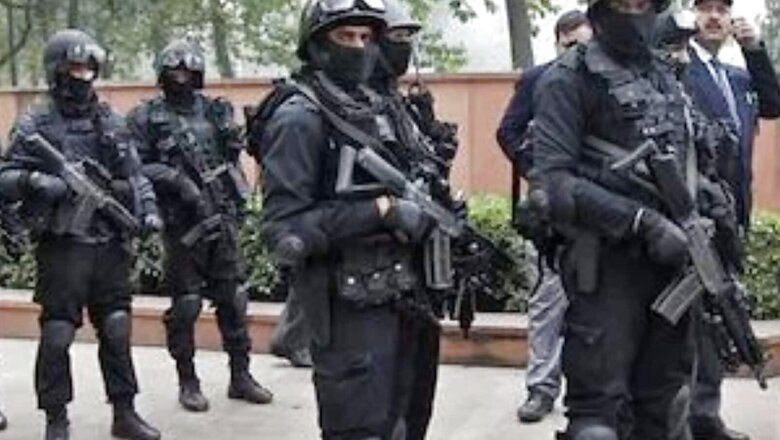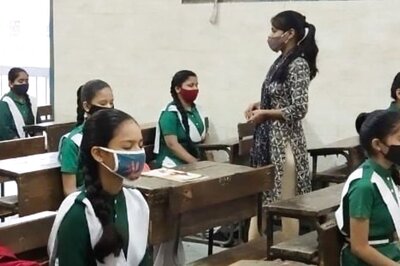
views
Zero Error— that is the mission of close to 7,000 commandos and officers of the National Security Guard (NSG). The NSG is among the world’s most highly trained and well-equipped forces that can deal with any situation. The best and fittest jawans and officers picked up for the NSG undergo several rounds of training and tough tests. The National Security Guard is a dual and deadly combination of jawans from the Central Armed Police Forces and the Indian Army.
The NSG was conceptualised and created after studying and analysing special forces of the British Army (Special Air Service), Germany’s Border Guard Group 9, Sayeret Matkal of Israel, and Delta Force of the United States. It was constituted to deal with any kind of hostage scenario or terror attack.
The teams of NSG work on a basic philosophy of swift and speedy strike and immediate withdrawal from the theatre of action. The force is task-oriented and has two main elements in the form of the Special Action Group (SAG) comprising Army personnel, and the Special Ranger Group (SRG), comprising personnel drawn from the Central Armed Police Forces and State Police Forces.
The NSG also has a National Bomb Data Centre that maintains a centralised database of bombing activities reported in India and abroad. The NBDC collects, collates, analyses, and evaluates all terrorist bombing activities and disseminates relevant information to concerned law enforcement agencies.
Only selected VVIPs get cover from the NSG’s Black Cat commandoes, including defence minister Rajnath Singh and Uttar Pradesh chief minister Yogi Adityanath.
History
Just after India came out from the shock of Operation Blue Star, the government decided to have a federal contingency force to deal with any kind of terror attack and hostage situation. On May 16, 1984, the cabinet committee on political affairs (CCPA) approved raising a special peacekeeping force to be called the National Security Guard (NSG). On January 4, 1985, a committee headed by the cabinet secretary was formed to decide the structure and other requirements of the force. The committee decided that for the time being the total size of the force would not exceed 5,000, there would be no colour service, and the NSG would be entirely based on deputation from the Army and CAPFs. Finally, after the approval of the then President of India, the force was created purely on a deputation basis.
Strength and structure
The force started with a total strength of 5,000 highly trained officers and jawans, and in the past almost four decades, only 2,000 more have been added, as the motto of the force is to have the best.
The NSG is headed by an IPS officer at the director general rank who supervises four inspectors general including a major general-rank officer of the Indian Army who is IG (operations). Other IGs head training, provisioning, and headquarters. Also, a joint secretary-level official also works under the DG who looks after the financial work of the organisation.
The NSG is divided into four groups —Special Action Group, which looks after counterterrorist and counterinsurgency operations and consists of commandos and officers from the Indian Army and CAPFs. Then there is the Special Ranger Group, which is a counterterror force and is used along with the SAG. Two teams of SRG are also responsible for giving protection to VVIPs. Also, there’s the Special Composite Group, which is headed by an Indian Army officer who works as group commander and heads regional hubs situated in Mumbai, Chennai, Hyderabad, Kolkata, and Gandhinagar. To back these groups, there is the Electronic Support Group, which gives technological and electronic support. The hub also has a Bomb Data Centre, which collects information on bombs, IEDs, etc, and analyses it to prepare reports to assist other law enforcement agencies.
Stories of valour
Just after the NSG was born, in 1986 it carried out its first big exercise, Operation Black Thunder. The operation was conducted in two parts in Amritsar to flush out terrorists from the Golden Temple complex in 1986 and 1988. In both operations, the SAG and SRG took part and completed the task. In operation Black Thunder-I, a total of 122 suspects were apprehended, and its second part ensured the sanctity of Harmandir Sahib and Akal Takht. A total of 192 terrorists surrendered.
A year later, the NSG in 1989 conducted Operation Cloudburst in Tarn Taran, Punjab. The counterterror operation was conducted in two phases spread over two months. Special Action Group, Special Ranger Group with Communication Group, Support Weapon Squadron and dog unit completed the task. A total of 29 officers, 73 assistant commandants, and 509 commandos/rangers were sent into Punjab for the operations. The NSG suffered two fatal and nine non-fatal bullet/splinter injuries and eliminated 16 hardcore terrorists.
In 1993, the NSG once again operated in Punjab, this time in Amritsar. This counter-hijack operation was conducted on April 24, 1993, by the Black Cats, as Indian Airlines Flight IC-427 was taken over by a heavily armed terrorist of Hizbul Mujahideen. The flight with 141 passengers and crewmembers onboard was sought to be taken to Lahore, Pakistan. In a lightning strike spanning barely two minutes, the task force of 5 SAG men successfully conducted the astounding operation by firing only two shots to neutralise the terrorist. All hostages were rescued unhurt.
In 2002, NSG commandos eliminated two terrorists who entered the Akshardham Temple complex of Swami Narayan Trust in Gandhinagar, Gujarat. The terrorists killed 30 and injured about 100 people. The operation was launched by the NSG on the intervening night of September 24-25 to clear the complex of terrorists. Six officers, 23 junior commissioned officers, and 72 commandos participated. The personnel completed the operation in nine hours and eliminated both the terrorists.
One of the most famous exercises of the NSG was Operation Black Tornado in 2008, during the 26/11 attacks when Mumbai was targeted by a series of coordinated blasts, and shootouts by terrorists. The elite counterterrorist task force of the National Security Guard was roped in to end the national crisis. The operation speaks volumes of the dedicated devotion to duty, exemplary professionalism, raw courage, and bravery of the commandos who rescued 610 Indian nationals, and 110 foreign nationals, and eliminated eight hardcore terrorists in a gruelling operation that lasted nearly 60 hours. NSG commandos and officers who died for the nation were also awarded the Ashok Chakra (posthumous), apart from other gallantry medals.
Another big exercise by the NSG was conducted in Pathankot, named Operation Dhangu Suraksha. A group of highly trained and armed terrorists dressed in Army fatigues attacked the air force station, Pathankot. The SAG along with IG (Ops), NSG, reached the spot. After taking the site update, the team was split into three. After a few hours, a search and destroy method was utilised. Finally, an operation was concluded with confirmation regarding neutralisation of the last-remaining terrorists and after clearing the area the base was handed over to the air force commander.
Apart from these operations, the NSG has been involved in giving security cover to CWG New Delhi 2010 and during the Cricket World Cup semifinal match in 2011 between India and Pakistan at Mohali. This was the first time when teams from three hubs were called in.
Budget
The National Security Guard has a budget of Rs 1,293 crore for the financial year 2022-23. The budget has been consistently increasing in the last few years, considering the requirements of the elite force.
Training
Commandos of the NSG have to go through one of the toughest training processes. In fact, officers who have served in the NSG say that out of 100, only 15-20 jawans manage to clear all the sessions. In 14 months of training, every commando has to go through tough physical training divided into various elements. The commandos after clearing initial basic training move to advanced training, which is of nine months. The training makes a commando an expert in counterterrorism, house intervention, underwater operation, etc.
Once the commando clears all levels, it enables him to go for another exercise cum training with global high-skilled forces. Weapons handling is also an important component of training as the force has some of the best and latest weapons. Training also includes combat with no weapon, intelligence gathering, bomb-disposal skills, shooting skills, etc. Another important aspect of NSG training is night operations. The commando has to fulfil the command successfully within a limited time in a dark room.
NSG 2.0 and what is next
The NSG is keen to buy the latest anti-drone technology and will prepare its commandos to deal with technology-led attacks. The force in the next 10 years will have more hubs in different parts of the country and will increase its strength. The NSG is also trying to convert itself into a technically advanced force with more technically educated troops who can handle the latest equipment. Also, the force is trying to enhance its capabilities to counter IEDs to include chemical, biological, radiological, nuclear, and high-yield explosives.
Read all the Latest News India and Breaking News here




















Comments
0 comment